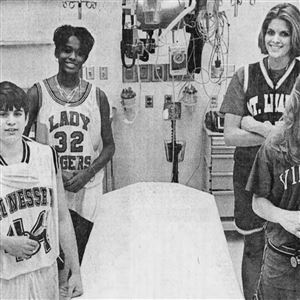In early December, Steelers running back James Conner was injured after catching a 10-yard pass against the Los Angeles Chargers.
His high ankle sprain has kept him from playing the past two games against the Oakland Raiders and the New England Patriots.
That’s not only disappointing for fans who have watched his rise into the National Football League from earlier days playing for the University of Pittsburgh and a battle with cancer. The injury is troubling for the Steelers organization, as each day an injured player is off the field is costly.
To try to reduce the number and severity of players’ injuries, the Steelers have begun working with a Silicon Valley startup called Sparta Science, which uses predictive analytics software to analyze injury risk for players and develops personalized training plans.
The startup began a pilot with the Steelers during summer training camp and the team has used the software throughout the season, said CEO and founder Phil Wagner.
“Our partnership with Sparta Science will help us toward our ultimate goal of better achieving and monitoring performance as well as prescribing and tracking rehabilitation to help keep our athletes on the field,” Garrett Giemont, strength and conditioning coordinator for the Steelers, said in a prepared statement.
On the player side, it’s easy to use the system: just step onto a force plate, which slightly resembles a bathroom scale, and either jump, balance or hold a plank for 60 seconds.
Players aren’t told much before they step on, because Mr. Wagner says, “The best technology is invisible.”
Thousands of data points are collected and analyzed through machine learning from the simple one-minute test. That can help determine which players may be at risk for a concussion or an elbow injury, for example.
Sparta’s software was formally released in 2014 and the company is partnering with two other NFL teams: the San Francisco 49ers and Detroit Lions.
The company also works with the NBA’s Cleveland Cavaliers and Major League Baseball’s Seattle Mariners and Colorado Rockies.
Mr. Wagner said at the collegiate level, football teams using the system have seen savings in the hundreds of thousands of dollars because insurance rates drop — less injuries, lower premiums.
On the NFL side, it’s harder to say what the savings have been because you must measure how many fewer days players are off the field and then base that on each player’s prorated salary.
“We generally have been able to save 18 percent of all injuries for a given NFL team,” he said.
Each game, players in the NFL can expect a 4.1 percent chance that they’ll be injured and unable to perform in the next game, according to ProFootballLogic.com, a website that tracks and analyzes sports data.
Injury rates are consistent across positions for the most part, with the exception of running backs, like James Conner, who suffer more injuries with longer recovery times. All in all, the website reports, a player can expect to hit the field 14.2 out of the 16 games each season.
Sparta is not the only company the Steelers are working with to improve injury rates. The organization is also working with San Diego-based Activbody to track and measure muscle strength and a number of performance equipment and fitness companies.
Meanwhile, the NFL is preoccupied with concussions, which have risen 13.5 percent between 2016 and 2017, according to the league’s website. The league is spending $100 million to research head trauma and support technological solutions, like better helmets, for example.
Menlo Park, Calif.-based Sparta has raised at least $9.7 million in funding, according to Crunchbase.
As for cost to use the system, it depends on the size of the group Sparta is working with and the type of application, Mr. Wagner said. The startup works with the military, which pays the most for Sparta’s software, into the millions.
Mr. Wagner, who played high school and college football before coaching teams in New Zealand and Australia, said he’s personally sustained repeated injuries.
“I was injured quite a bit in different areas of the body and I was kind of shocked,” said Mr. Wagner, who holds a degree in medicine from the University of Southern California. “It seemed like a pretty random approach to treating some of these injuries.”
Imagine trainers with clipboards standing around players lifting weights and on machines. There’s no clear way to measure individual players’ movement patterns, he said, because what’s done is “subjective screening.”
A trainer or coach may look at where your hips are compared to your knees when you squat, looking for trouble signs.
Mr. Wagner said it’s easy for players to skirt the trainers on these tests, whether consciously or not. “Athletes are exceptional at compensating ... one of the reasons they’re so successful is that they’re able to mask deficiencies really well.”
The 30-person Sparta team has collected and recorded over 800,000 anonymized events from the force plate, mostly focusing on individuals over time to create what he calls a “movement signature.” That helps create a standard to compare each player’s form against.
And the force plate can’t be tricked like a human trainer.
“When [players] do a vertical jump, they get on their toes like they’re reaching for a cabinet and slam the heels down,” Mr. Wagner said. “That allows you to jump higher, so teams may think, ‘Wow, they’re explosive,’ when the reality is he’s just good at beating that test.”
If any manipulation is sensed on the force plate, a loud buzzer goes off.
Once the testing is complete, Sparta can help coaches and trainers make informed decisions about specific training or rehabilitation players need.
“The nice piece that we’ve gotten feedback on is that because the test is so short, it allows more time for discussions of results and education,” Mr. Wagner said.
He said increased transparency between coaches, trainers and players also creates a more collaborative environment.
“A lot of times with data and technology, it’s not explained to athletes, it breeds suspicion. Are they going to cut me or change my contract?” Mr. Wagner said.
“I think we’re seeing the same phenomenon in medicine, that doctors are sharing more information with their patients in the medical file.”
So you can safely bet James Conner has been given a data-driven recovery plan.
Courtney Linder: clinder@post-gazette.com or 412-263-1707. Twitter: @LinderPG.
Correction, posted Dec. 21, 2018: This story has been updated to reflect the professional sports teams that work with Sparta Science.
First Published: December 21, 2018, 12:30 p.m.
Updated: December 21, 2018, 1:05 p.m.





















